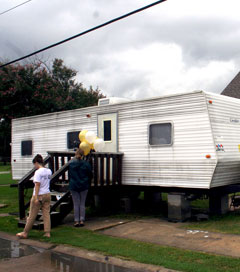Late last week, the Department of Health and Human Services classified formaldehyde as “a known carcinogen,” adding its verdict to two similar reports released by key agencies since 2009.
But despite the growing scientific consensus about how formaldehyde can affect human health, it remains to be seen if the studies will lead to tighter U.S. formaldehyde regulations.
As we've previously reported, the Environmental Protection Agency has been trying to update its chemical risk assessment for formaldehyde since 1998, but has been stalled repeatedly by the chemical manufacturing industry.
EPA assessments are the country's gold standard for how dangerous a chemical is. The formaldehyde assessment would undoubtedly influence the stringency of a rule the EPA is developing on how much of the chemical can safely be released from construction materials that contain it.
In 2009, Sen. David Vitter, R-La., maneuvered successfully to delay the assessment by putting a hold on the nomination of a key EPA appointee and forcing the agency to send its draft to the National Academy of Sciences for review.
Vitter has received substantial campaign contributions from the nation's largest formaldehyde manufacturers and users. After the EPA agreed to send its assessment to the NAS, a top industry lobbyist, Charles Grizzle, threw Vitter a fundraising party [6], requesting donations of $1,000 a plate.
Do you like this? Click here to get Truthout stories sent to your inbox every day – free.
The NAS finished reviewing the EPA assessment in April, sending back a long list of questions and advising the EPA not to finalize the document until it could show exactly how formaldehyde causes cancer, a biological mechanism known as the “mode of action.”
Dr. Peter Infante, a former director of the Office of Carcinogen Identification and Classification at the Occupational Safety and Health Administration, called the NAS critique “arrogant” because “we don't know the mode of action for most things that cause cancer.”
Christopher De Rosa, a former senior toxicologist for the Centers for Disease Control, said the HHS study might “galvanize the EPA's political will to go forward with the risk assessment because it represents a convergence of opinions worldwide in terms of formaldehyde being a known carcinogen.”
A spokesperson for the EPA did not respond to questions about how the HHS report will affect the EPA's risk assessment.
The American Chemistry Council, a trade group that represents the chemical industry, said in a written statement that the HHS report flies in the face of the Obama administration's commitment to sound science.
“We are extremely concerned that politics may have hijacked the scientific process and believe this report by HHS is an egregious contradiction to what the president said early in his administration,” said Chemistry Council Chief Executive Cal Dooley.
Our most important fundraising appeal of the year
December is the most critical time of year for Truthout, because our nonprofit news is funded almost entirely by individual donations from readers like you. So before you navigate away, we ask that you take just a second to support Truthout with a tax-deductible donation.
This year is a little different. We are up against a far-reaching, wide-scale attack on press freedom coming from the Trump administration. 2025 was a year of frightening censorship, news industry corporate consolidation, and worsening financial conditions for progressive nonprofits across the board.
We can only resist Trump’s agenda by cultivating a strong base of support. The right-wing mediasphere is funded comfortably by billionaire owners and venture capitalist philanthropists. At Truthout, we have you.
We’ve set an ambitious target for our year-end campaign — a goal of $250,000 to keep up our fight against authoritarianism in 2026. Please take a meaningful action in this fight: make a one-time or monthly donation to Truthout before December 31. If you have the means, please dig deep.
